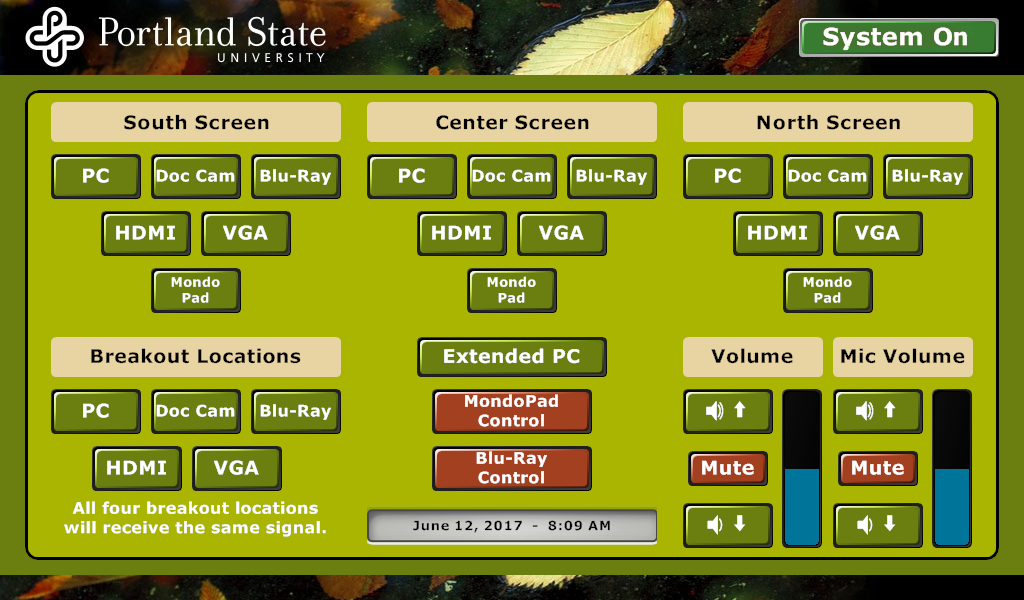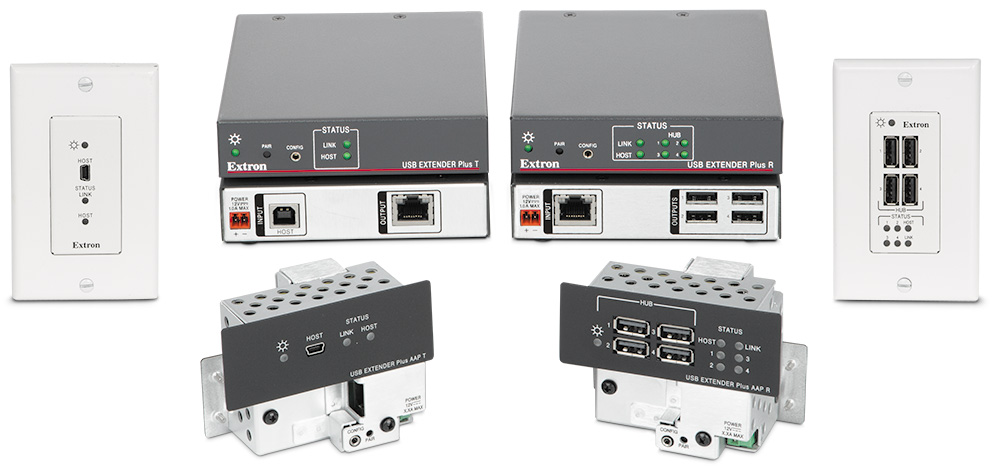
Extron DTP Systems and USB Products Empower PSU’s Immersive Environment
Portland State University – PSU in Oregon was awarded a $1.5 million grant from the Economic Development Administration to vastly expand campus utility metering and research. This included the creation of a facility to visualize, analyze, and share the gathered data. Designed along the lines of the Decision Theaters at Utah State University and the University of Chicago, the Data Visualization Studio at Portland State University’s Institute for Sustainable Solutions, enables campus and regional stakeholders to analyze and compare utility data findings and research alternatives. PSU is also able to institute problem solving to reduce their carbon footprint.
The Data Visualization Studio provides a variety of visualization options, powerful computing, robust video conferencing capabilities, and a collaborative environment that can be broken out for team and individual research projects. An Extron DTP CrossPoint 4K Series matrix switcher, USB Extender Plus transmitters and receivers, and an IP Link ® control system enable selective AV signal switching and distribution for display on the studio’s videowall and four satellite workstations.
“First and foremost, we’re an Extron shop because they have a wide range of reliable, high-performance product lines that can accomplish our goals of connectivity, switching, distribution, and control to the point of our satisfaction,” says Doug McCartney, Director of Instructional Technology Services, OIT, at Portland State University and Past-President of the Consortium of College and University Media Centers. “Extron products and solutions are designed in such a way that we’re confident and comfortable programming and servicing them ourselves.”
Extron products and solutions are designed in such a way that we’re confident and comfortable programming and servicing them ourselves.
Needs Analysis and Design Details
The original intent of the project was to be able to meter and visualize utilities data for the campus buildings, including electricity, natural gas, steam, potable and chilled water, along with the various irrigation systems. The thought was to install a videowall that could display a single large picture or multiple smaller images. However, the vision grew when the university team, which consisted of the Institute for Sustainable Solutions, the Department of Research and Planning, Capital Projects and Planning, and the Office for information Technology – OIT realized all that could be accomplished with the Data Visualization Studio. This was true not only for the university, but for regional and national entities as well.
Located in Room 123 in the Market Center Building, the studio’s immersive multimedia environment features display options that support a variety of collaboration, and independent work models. The AV system provides simultaneous large-scale visualization of data, graphics, images, and videoconferencing feeds on a 1x3 videowall at the head end of the rectangular, 900‑square foot (84‑square meter) room. Four workstation areas are available and located at the north, south, and west walls. The same image can be stretched across the videowall’s three 80" InFocus ® Mondopad touch displays and sent to each workstation’s 70" touch display, which is installed on a sliding, ADA‑compliant mount. Alternatively, each display can support an independent huddle space.
The AV equipment is installed within a podium that is on a 10‑foot (3‑meter) umbilical cord. A raceway under the bank of windows on the long east wall connects the videowall displays to the system. These displays are mounted on a steel rig that stands away from the windows to allow smooth operation of the black-out blinds and easy servicing. Three monitors on the podium serve as confidence monitors for the presenter, mirroring the content shown on the 80” displays.
Meter data from university and non‑PSU buildings on campus is routed through the building automation system to a specialized analytics software program for data crunching. The user then stages and presents the information on the selected displays. Up to seven users can isolate and display visualized data, simultaneously.
Ultimate AV Flexibility with DTP CrossPoint 4K Series Matrix Switching
An Extron DTP CrossPoint 108 4K presentation matrix switcher with built‑in seamless 4K scaling provides AV signal switching and distribution in the various space usability configurations. This 10x8 matrix switcher was selected for its capability to fulfill important application and performance requirements, such as HDMI and DTP ® twisted pair inputs and outputs that support 4K video resolutions and integrated audio DSP with AEC for videoconferencing needs. Extron Vector™ 4K scaling technology applies 4:4:4 chroma sampling and 10‑bit processing to provide enhanced color accuracy and picture detail on each scaled output.
Other studio resources connected through the DTP CrossPoint ® presentation matrix switcher include a computer, a Blu‑ray player, a document camera, and a wireless microphone system. The computer has three outputs going into the matrix switcher, enabling the desktop to be extended across the videowall. At the podium and each workstation, Extron AAP plates provide AV connectivity for portable sources with HDMI or VGA plus audio outputs. An Extron RGB‑HDMI 300 A converts analog signals for input to the matrix switcher.
AV and control signals are extended over the CAT 6 infrastructure using Extron DTP HDMI 4K 330 Series transmitters and receivers in conjunction with the DTP CrossPoint matrix switcher. An Extron DTP HD DA 4K 330 distribution amplifier is connected to one of the HDMI outputs on the DTP CrossPoint 4K switcher. This supports applications where a single source such as the document camera must be distributed to all four satellite workstations while different content is displayed on the 1x3 videowall. This arrangement leaves the videowall free for display of other material and videoconferencing camera feeds.
All AV system operations are controlled using a TouchLink touchpanel and IPCP 505 control processor that are integrated into the podium. An Extron MLC 104 IP Plus AAP MediaLink® controller with Ethernet and AV connectivity mounted next to each workstation display allows individual huddle space control, completing the AV switching system.
Extron USB Products for Easy Sharing of KVM
Integration of Extron’s SW2 USB two‑input switcher, USB HUB4 AAP four‑port USB hub in an architectural form factor, and a USB Extender Plus Series transmitter and receiver pair enable distribution of keyboard-video-mouse – KVM and connected USB source signals to the videowall’s three touch displays. The USB switching and extension system is separate from the AV distribution system. The hub sends signals from connected devices to the computer, and the USB Extender Plus T transmitter installed with the host computer sends all USB signals to the receiver over the CAT 6 cable. Peripheral emulation on the transmitter supports uninterrupted communication and ensures the USB port is recognized when the system is powered on. Transmission distances throughout the studio were within the 330 foot (100 meter) capabilities of both the DTP and USB extenders.
The videowall displays receive USB signals from three of the four USB outputs on the Extron USB Extender Plus R receiver. The SW2 USB switcher connected to the fourth USB output enables images from the integrated videoconferencing camera system on the touch displays to be shared. In addition to receiving signals from the transmitter, the receiver accepts USB signals from the internal computer on the central touch display.
“The Extron USB products allow us to share content from someone’s USB device and to switch between KVM content sourced from the computer in the podium or use the touch interface from any point on the videowall to select and display material, a feed, or some combination of these,” says James Hatfield, Information Technology Consultant, OIT, at Portland State University. “Switching with the SW2 USB reboots the USB sources every time the system is turned on, which keeps it very stable.”
Results
PSU's Data Visualization Studio is utilized by the academic departments and regional stakeholders on a daily basis. It is also a key piece to the creation of the Energy Efficiency Certificate designed to fulfill the needs of local industry in the engineering, construction, and sustainability sectors. Scheduling of the studio is under the jurisdiction of PSU’s Institute of Sustainable Solutions, and the award-winning OIT team maintains the installation.
The facility is also used to host events for community, environmental, and sustainability organizations. A recent conference hosted for the US Department of Forestry Service was a successful and informative test of the system’s extensive capabilities. The studio served as the hub of an interactive conference between a myriad of locations. Local and remote presenters shared slides, statistical data, and video within the room and to distant sites during general briefings, brain-storming collaborations, and break-out sessions among specific groups.
For the university and their partnering organizations invested in sustainability practices, the Data Visualization Studio continually provides a new way to examine data, support learning, and accelerate research using technology.
“Visualization and AV‑based collaboration in an immersive environment help us see patterns in an otherwise overwhelming flood of data,” says Doug McCartney at Portland State University. “Our multi-purpose Data Visualization Studio, with its high-performance Extron AV system, allows individuals and groups of researchers and community members to easily visualize data and collaborate with others, both on and off campus.”












 Chrome
Chrome
 Firefox
Firefox
 Edge
Edge
 Safari
Safari